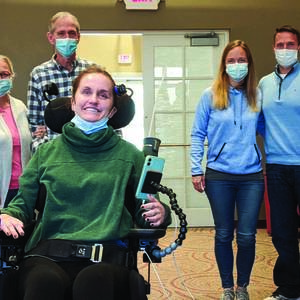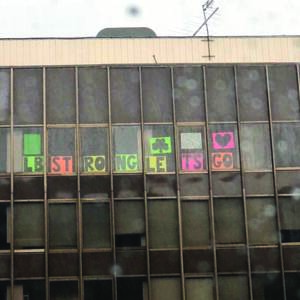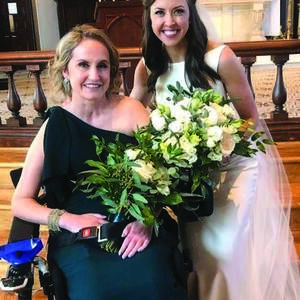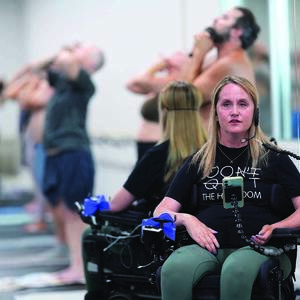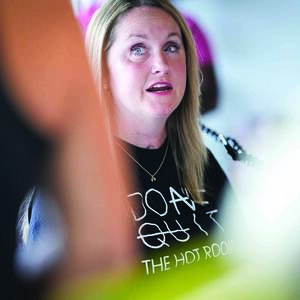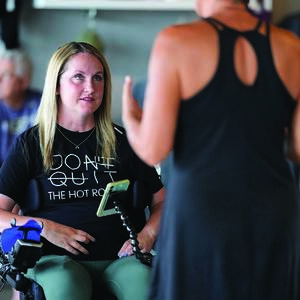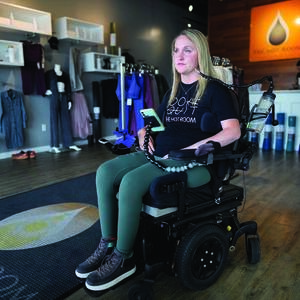Considering everything that had already gone wrong that day, no one would have blamed Laura Burdick ’10 if she hadn’t followed through on her plans — particularly the risk she wanted to take.
This was Burdick’s first appearance in public in her motorized wheelchair, 10 months after the horrific accident that nearly killed her and left her mostly paralyzed. Yet as Clare Brady’s maid of honor at her wedding in March 2021, Burdick had promised herself to do everything she could to make the day amazing for her friend, one of the most important people in her life since they became close during their freshman year at Notre Dame.
Burdick kept that promise even when the driver of the vehicle taking her to the church pushed her legs into a tight spot on an access ramp, cutting her heel badly. Still, in the rush to get her foot bandaged before her last-second arrival with her parents, Burdick focused on Brady ’10 and the groom, Scott Lauber.
The challenges continued when it was Burdick’s turn to give her toast before 200 wedding guests. She had a copy of her toast on a music stand and was ready to read it. But the lights were too low, and she couldn’t get close enough to the stand.
Undaunted, Burdick smiled and began to speak from memory what she had practiced for so long. Comparing the COVID-19 pandemic to the splendor of the reception, she deadpanned, “It’s no surprise that after all the fancy events we’ve been to in the past year, the Bradys kept it nice and casual.” As everyone laughed, she added, “So, I’m just going to stay seated for my toast.”
When the crowd roared and cheered at that line, Burdick knew she had pulled off the risk she had needed to take: to let people know she was still Laura Burdick and not a woman defined by her injuries or her wheelchair. Doing so let her shift the spotlight off herself and shine it on her friends. From that moment, she shared poignant memories with Clare, tributes to the couple’s love and some gentle pokes of humor at her friend.
Then came the message near the end of her toast: “I’ve been through a lot of events in my lifetime, and something I’ve learned is that the people that you need are the ones that show up. And so, when someone says, ‘Why is Clare your best friend,’ it’s because Clare shows up. And I know I can overcome any battle when she is by my side. And Scott, it’s obvious that you show up for Clare, and she wants to show up for you. All we can do is just show up for each other.”
As Burdick finished, her friend rushed to hug her.
“I have friends who barely know Laura who will text me from other weddings and say, ‘Maid-of-honor speech still wasn’t as good as Laura’s,’” Clare Brady Lauber says today.
Laura Burdick believes we should all ask ourselves one question: What is my “why”? What is my foundation in life, my reason for living?
“The ‘why’ is so important, because it helps you get in touch with what you are able to contribute to the world,” she says. “Your why comes from a skill set that is specific to you and brings you joy.
“It is your why that is the reason we are all here in the first place.”
If you look at everything she had done in her 32 years before the accident, Burdick’s “why” was clear. It was as if she had made what she considered the fairest deal with Life: In return for the great gift of living, I will give it my all, help others to live their best lives, and approach everything I do with preparation, hard work, a touch of boldness and an abundance of love.
Before high school, Burdick had set herself a goal of earning 12 varsity letters. She earned 14 — in soccer, cross country, basketball and tennis. At Notre Dame, she made the women’s rowing team as a freshman even though she had never rowed before. She managed football pep rallies for a year and became president of Cavanaugh Hall. Even when she lost a close race to become student body president, she never flinched from putting herself on the line.
After graduation, Burdick ran marathons. She traveled to Italy, Mexico and Brazil. She earned a master’s degree in public health from St. Louis University, turning her interests in nutrition and physical wellness into a career. She led yoga studios in Chicago and Indianapolis, managing about 60 employees, and started her own business as a health and nutrition coach. She helped people overcome eating disorders, rebound from injuries and illnesses, and encouraged and pushed them to live their dreams.
She also moved to Indianapolis to be close to her two siblings and their children, wanting to support her nieces and nephews in their activities, so they would “know they have another adult in their corner,” she says.
“I knew my life was good at the time,” she says. “I also had a very good social life with lots of friends and a boyfriend that I was very serious with. I worked a lot of hours, but I loved it.” Still, she kept flexible so she could show up for people when they needed her. “My spiritual life was also in a good place. I am the godmother to three of the four of my nieces and nephews, and I take that role very seriously. I thought it was important that I walked the walk on the faith.”
Yet even while our lives may be fulfilling, even breathtaking, they also take heartbreaking turns no one can prepare for: a cancer diagnosis, a miscarriage, the sudden death of a loved one. In Burdick’s case, it was a drunken driver.
At 9:30 p.m. on Friday, May 29, 2020, she was driving her SUV along a frontage road that parallels Interstate 94 in Chicago when a woman who witnesses said had been driving on the highway erratically at a high rate of speed lost control of her vehicle. It plummeted off the interstate, crashed through a fence, went airborne and struck Burdick’s SUV head on — crushing it and her.
Burdick suffered a severe spinal cord injury and a traumatic brain injury.
The other driver, whose blood alcohol level was later determined to be .125 — well above the legal limit of .08 — died from her injuries. At times Burdick has wondered if it would have been better had she died that night, too.
Six days after the accident, Katie Burdick Pettit ’02, created a page for her younger sister at CaringBridge.org, to keep all her loved ones informed. On June 10, Pettit posted this urgent plea: “Please say a prayer for Laura and her family this evening. She had a sudden change this afternoon and went unresponsive. Imaging of her brain showed that fluid was building up and causing pressure on her brain. She had to have an emergent drain placed to relieve the pressure. We knew this journey wouldn’t be straightforward, but this could be a devastating change. At this point, we have to wait and see if and when she wakes up again and hope the pressure on her brain did not cause permanent injury.”
Pettit’s posts chronicled her sister’s ordeal in the hospital that summer. The lows included the loneliness and fear Burdick felt at the height of the pandemic, when even family members were seldom allowed to visit. Her parents, Jim ’76 and Ellen Burdick, suffered with the barriers that stood between them and the youngest of their three children.
The toughest part was their daughter’s initial reaction to her injury. “My thought was, ‘I can’t be like this forever,’” Burdick recalls. “Without a doubt, the hardest thing a person can go through in their life is losing their physical function.” She felt for all the people who cared about her and were praying for her recovery. “I thought about the number of times my parents had to tell me what was wrong with me . . . having to watch me cope with all of that and still see me today struggle and try. People have gone through their own grieving process about losing who I was. There was also a long period of time when there was no certainty that I was going to survive. I think there were people who grieved my death back then.”
Others continued to celebrate Burdick’s life. On her birthday that summer, friends from Notre Dame and her high school in Terre Haute, Indiana, talked the owner of the apartment building across the street from the windows of Burdick’s hospital room into allowing them to use an empty apartment so they could hold up signs sending her birthday wishes and their love.
Then, in September, came an even better moment. By then, Burdick’s brain had healed. Days before she left the hospital, her voice sometimes weak and halting, she created a video message for those people who had made nearly 200,000 visits to her CaringBridge page. The message was vintage Laura Burdick.
“Tonight, we’re going to talk about something a little bit deeper than what we normally do. And that is your ‘why,’” she said. “Maybe your goal is about your body. Maybe it’s about your work. Maybe it’s about your kids. Whatever it is, I want to make sure I’m capable of helping you get there. So, what I encourage you to do is sit down with your goal, and with a piece of paper, write your goal, and write, ‘Why.’ I want you to get really specific about your ‘why’. So, sit down, do the work and watch your goals soar. Let’s get this.”
Eight days later, Burdick was flown by air ambulance to the world-class QLI rehabilitation center in Omaha, Nebraska — the start of a new journey to make the most of her life, and touch the lives of others, while facing her biggest challenge ever.
‘I imagine that, at the scene of the accident, God had a choice or a plan to take me then or to allow me to live. Allowing me to live like this is definitely harder than it would’ve been just to go up to heaven right then.’
Burdick’s 10 months in Omaha are marked by many stories of people living their “why,” starting with the depth of a mother’s and father’s love.
Jim and Ellen Burdick moved nearly 600 miles from Indiana to Omaha to support her, even though COVID restrictions meant visits of no more than one hour per week for several months of that span. They rented a pet-friendly apartment so they could occasionally boost their daughter’s spirits by bringing along Lula, her then-9-year-old rescue dog.
“We just felt we needed to be there for her,” Ellen Burdick says.
That time in Omaha is also marked by great stories of friendship, including one involving Kim Hamill Maxwell, who along with Laura Burdick and Clare Brady Lauber is one of a group of friends from the Class of 2010 who have stayed tight — a group that also includes Kristen Vercruysse Carlson, Danielle Straccia Sih, Molly Conway Hjelm, Jacquelyn Daubert Levy, Alex Penaranda and Jackie Spengler Lewis.
“Laura is the core, the glue for all of us,” Maxwell says. “She’s the one who was always planning things and making sure everyone was happy and feeling good about themselves.”
To illustrate the point, Maxwell shares a story that revolves around her own parents’ divorce, which led to a distance between her and some relatives on her father’s side of the family that lasted more than 15 years. Several years ago, when her father called to tell her that his mother had died, Maxwell wanted to pay her respects. As she made plans to fly from Florida to Chicago for the wake and the funeral, she shared with Burdick her anxiety about the trip. Burdick insisted on driving from her home in Indianapolis to support her friend through the long weekend.
“She was by my side the whole time — the wake, the funeral,” Maxwell says. “I didn’t realize how overwhelming the situation was going to be. Through all the ups and downs of the weekend, she was there for me.”
That weekend is one of the reasons Maxwell also asked Burdick to be her maid of honor. And when she learned that Jim and Ellen Burdick had to return to Indiana one weekend during their stay in Omaha, she rearranged her schedule to fly there to be with their daughter at QLI.
Laura Burdick would have the same impact on the staff of the rehabilitation center.
“We don’t expect this of people, but she was always asking, ‘How is your day going? How are the kids? What are you doing this weekend?’ I think that’s why everyone loved working with her so much,” says Erin Young, who was Burdick’s occupational therapist at QLI. “She’s just so interested and invested in other people, even while she’s going through the hardest thing in her life.”
Young credits Burdick’s positive attitude with helping her make physical progress that didn’t always make sense, given her C5 spinal cord injury and the initial prognosis. A typical result of such an injury would be little to no movement or sensation in her wrists, core and legs. When Burdick was admitted, Young says, she was not able to position her hand on the joystick of her power wheelchair. She really wanted that independence. In short order, she was able to drive herself all over the QLI campus.
Burdick also increased her range of motion to do two other important things — feed herself with setup support and give hugs to the people she loves. Yet as significant as these advances were to restore some measure of independence, the QLI staff also sought to help her regain the volume and clarity of her voice, a vital part of her work and identity. Burdick wanted to sound like herself again.
The therapists focused on strengthening her diaphragm in a creative way — getting Burdick to project her voice by teaching a yoga class to the QLI staff. And then a wondrous thing happened. The staff loved her tough-yet-encouraging style so much that the therapy sessions became weekly classes, which led to Zoom classes with the students at Burdick’s Indianapolis studio.
“She’s such a coach. She’s such a leader,” says Young, who participated in the classes. “When you see somebody in their element, you can’t help but think, ‘Wow! This is your thing. This is where you shine.’”
Ever since, Burdick has used her voice to get back to her original mission — helping people be their best. With an emphasis on showing up for the people you love, finding your purpose and striving to achieve your dreams, she has given talks to a women’s conference in Terre Haute and a gathering of some 800 businesspeople in Chicago, among others. Today she is considering whether to pursue a doctorate in public health. And she’s started writing a book about her journey.
Still, another “why” haunts her: “Why, God, did all this have to happen?”
That question led Burdick to take part last spring in “Rooted,” a program at an Indianapolis church designed to help people find their purpose in God. Burdick’s discussion group consisted of 10 women in their 30s and 40s who shared their stories, which included the heartbreaks of miscarriage, of trouble getting pregnant, of abusive relationships. Burdick shared her story, too.
“There are lots of different reasons that people have concerns and struggles with keeping their faith and coming back to God,” she says.
“I have always been a very firm believer and practice Catholicism pretty devoutly. I think if you ask several of my friends they would say that I even was an influencer for them to get more involved in their faith. While I have maintained my faith and prayer life since my accident, it is fair to say that my conversations with God are a bit tougher. I have begged and pleaded in prayer to hear something back from him about why this is my scenario, and what the heck am I supposed to do with it?”
She says she has had these thoughts “pretty consistently” during the three-plus years since the accident. “I imagine that, at the scene of the accident, God had a choice or a plan to take me then or to allow me to live. Allowing me to live like this is definitely harder than it would’ve been just to go up to heaven right then,” she says. “Had I lost my life at that time it would have been very hard on my family and friends, but I believe that their role in my life now is even harder. Due to my faith, I try to use the fact that God did save me to propel me toward something.
“Certainly there is a plan and something I am supposed to do to help a lot of people. Because what would be the point otherwise?
“I believe that a lot of the work that I do relates back to my purpose from God. So yes, I lived in the physical activity and nutrition world, but it was because I believed that was how God knew I could best help people. When I put forward the challenge for people to set a 90-day goal so quickly after my injury, it was because I knew there had to be a reason for my life to be like it was,” she says.
“I still battle with it, but I want to continue to do battle with it so that I am at least continuing to talk to God.”
Like many people, Burdick sometimes gets torn between the blessings she has lost and the ones she still has, between the dreams she’s had to give up and the ones she still embraces.
On Mother’s Day this year, she woke up struggling with the thought that her dream of becoming a mother would never happen. Then her 8-year-old niece, Riley, and her 6-year-old nephew, Spencer, bounded into her room with huge smiles and the gift of a T-shirt for her that read, “Rockin’ the Dog Mom and Aunt Life.”
“Mother’s Day is a tough one for me,” she wrote in a social media post that day. “It is a journey that I desire for myself. When I became an aunt, I felt my heart double, triple, quadruple in size, and I knew that I did want to be a mom myself.
“Sure, their parents deserve some credit,” she joked, “but they look so cute holding up the T-shirt! Do they have any idea how important their love is to me? No. So dog mom and aunt it is. Guess I better rock it!”
Burdick lives in the same suburban Indianapolis home as Riley, Spencer and their parents — her brother Mark ’05 and her sister-in-law Stephanie. Her sister and brother-in-law, Katie and Chris Pettit ’02, and their children, Hannah and Keegan, live nearby. Her parents come in from Terre Haute frequently. Relatives and friends from high school and Notre Dame visit, too. All are bound in a love that strives to overcome life’s challenges.
In Laura’s wing of the house is an exercise room where an athletic trainer works out with her once a week. Twice a week she works with physical therapists at a nearby rehabilitation center for people who have suffered a neurological injury.
“I try to stay as active as I can and do therapy and strengthen what I have — to get stronger and stronger,” she says. “I very much have believed in the goals of activity, strength and nutrition my whole life. Also, in the event science comes around and finds a solution so my body can be healed, I want to be in shape to do the therapy necessary so I can get up and walk.”
Burdick has another dream, which ties into the way that — according to friends and family — she continues to “show up” for them through phone calls, emails, texts and gifts.
“I’ve realized how valuable it is to consistently show up in whatever way the person that you love needs you to show up,” she says. “As time passes and you get further away from the incident, people move on. But I still need people to show up. There are few things more fulfilling than when someone reaches out to me now and says, ‘Hey, I need your help with something.’ Like they still acknowledge my expertise.”
On a sunny morning in June, Burdick, clad in black yoga pants and a fluorescent-lime tee, steers her wheelchair into a “hot yoga” studio in Indianapolis, where she meets wave after wave of huge smiles, long hugs and kisses on her cheeks and forehead. It’s a fitting homecoming from the family of women and men she taught, trained with and befriended in her 10 years here as a student and instructor — the studio family that held a prayer vigil for her here after the accident.
Burdick has returned to lead a class in a room where the temperature is set to 105 degrees, and where 26 women and men, ranging from beginners to veterans, await her instructions that will leave them dripping with sweat.
“I didn’t know if I’d be jealous because I couldn’t do the workouts,” she says. “But I’m just happy that people are doing this. I’m like, ‘Good! You can be doing this. You should be doing this.’ I do like being up there and teaching.”
For the next hour, she delivers her instructions smoothly, rhythmically, adding touches of humor and a steady supply of encouragement. Near the end of the class, she tells the group to “acknowledge the good things you’ve done, celebrate them, and then get back to work.”
It’s no stretch to believe those words of wisdom are among the talks she gives herself, too. After class, students return to the cooler lobby, giving her thanks, hugs and a bouquet of flowers. “When I see people make adjustments to the things that I say, or they work harder because I encourage them, I feel trusted,” she says. “I like that I can still positively influence those around me.”
The passion and joy in Burdick’s voice recall the first social-media post she made after the accident:
Life,
Despite your best efforts, I’m STILL here. I plan to live you out loud.
Me
More than two years after that post, she is asked what she would tell Life now.
“I still desire and feel motivated to do big things,” she says. “I want to be impactful. If this is my scenario, then I’m going to use it to still make a difference and help people.”
An even more powerful determination marks her voice as she vows to keep showing up, to live out loud: “I’m not going to fade into the background and disappear.”
John Shaughnessy’s four books include The Irish Way of Life: Stories of Family, Faith and Friendship. He is assistant editor of The Criterion, the newspaper of the Archdiocese of Indianapolis.
